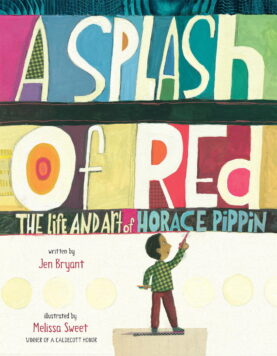SEL Read Aloud: A Splash of Red: The Life and Art of Horace Pippin by Jen Bryant

Summary
In “A Splash of Red” by Jen Bryant, Horace Pippin was a boy with big hands who loved to make art. Because he was so big and strong, he had many responsibilities in his family, but he drew pictures whenever free time he had. His classmates loved his artwork, and he even won a magazine contest for his drawings.
When Horace was in middle school, his father left their family, he had to work even harder to support his mother, brothers, and sisters, until he was called to fight in a war overseas as a young man. Just like when he was a boy, family, friends, and even his fellow soldiers encouraged him to draw more pictures.
But during the war, Horace was shot in his right arm, leaving him unable to do either manual labor or draw — a major change from his life before the war. As a married man, Horace was forced to do different kinds of work.
He longed to draw the way he did when he was younger, until one day when he decided to use his left hand to guide his right hand. As he practiced, he got better, and in middle age, his artwork finally caught the attention of the art world.
Comprehension Questions
Six questions aligned to Bloom’s taxonomy for teacher’s to evaluate students’ comprehension
- Remembering: Where did Horace Pippin and his family move when he was three?
- Understanding: How did Horace Pippin’s injury affect his ability to create art?
- Applying: What strategies did Horace Pippin use to overcome the challenge of his injured arm to continue painting?
- Analyzing: Discuss the significance of Horace Pippin adding a “splash of red” in his paintings.
- Evaluating: Consider the factors that led to Horace Pippin’s recognition in the art world. Which do you think were most crucial?
- Creating: If you were to design an art exhibition showcasing Horace Pippin’s work, how would you organize it to tell his story?
CASEL Discussion Questions
Five questions aligned to the CASEL competencies for teachers to foster an engaging discussion and foster social-emotional learning
- Self-Awareness: Reflect on a time when you discovered a personal strength during a difficult situation. How does Horace Pippin’s story inspire you to view your challenges differently?
- Self-Management: Horace worked on his paintings every day and late into the night, demonstrating strong self-discipline. Share an example of a goal you are working towards with persistence.
- Social Awareness: Discuss the importance of community support in Horace Pippin’s journey to becoming a recognized artist. How can communities support emerging talents today?
- Relationship Skills: Horace’s ability to express himself through art likely impacted his relationships. How can sharing our personal passions and interests help build deeper connections with others?
- Responsible Decision Making: Horace’s decision to join the army and later to focus on his art had significant impacts on his life and work. How can reflecting on potential outcomes guide our decision-making processes?
Design Thinking Challenge
Take students’ learning even further by incorporating the Imagineerz design thinking framework
Create Horace Pippin’s art easel
Understand
- Begin by exploring “A Splash of Red: The Life and Art of Horace Pippin” with your students. Discuss Horace Pippin’s journey as an artist, focusing on his perseverance, creativity, and how he overcame obstacles to pursue his passion for painting, even after his injury. Highlight the significance of his self-made tools and techniques that enabled him to create art again.
Ideate
- Challenge students to think about how Horace Pippin might have created his artwork with limited resources and one functioning arm. Ask them to brainstorm ideas for designing an art easel that could have helped Horace paint more comfortably or efficiently, considering his physical challenges. Encourage them to think about the materials he had access to and how he adapted his methods.
Prototype
- Using recycled materials (cardboard boxes, fabric scraps, plastic bottles, etc.), students will construct a prototype of their innovative art easel design. This easel should reflect the constraints Horace faced and offer a creative solution that would have supported his artistic process. Encourage students to incorporate features that adjust for height or angle, considering Horace’s need to paint with one hand.
Test
- Have students present their art easel prototypes to the class, explaining how their design addresses Horace Pippin’s needs and how it would assist him or any artist with similar challenges today. Discuss the functionality of each easel, focusing on its stability, adjustability, and how well it might accommodate an artist working with limited mobility.
Read Aloud
If you appreciated getting to read this book with your class, you might also want to share this book with them!
Additional Resources
Copyright Notice
The image on this page comes from the book A Splash of Red: The Life and Art of Horace Pippin by Jen Bryant. Copyright © 2013 by Jen Bryant.


